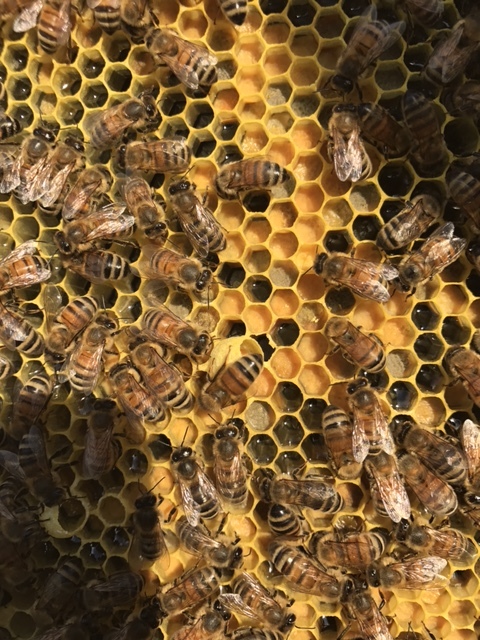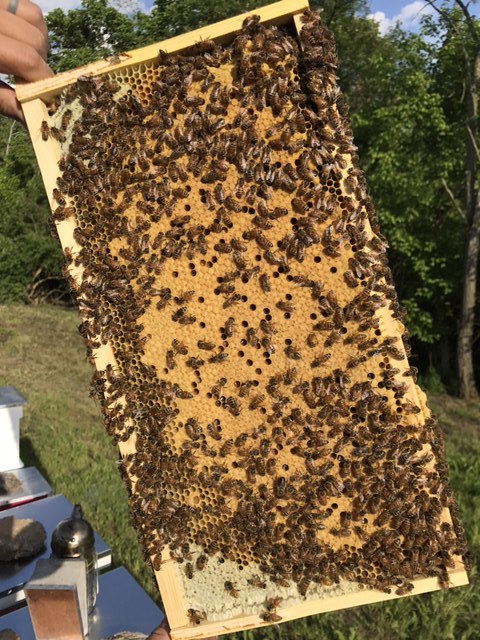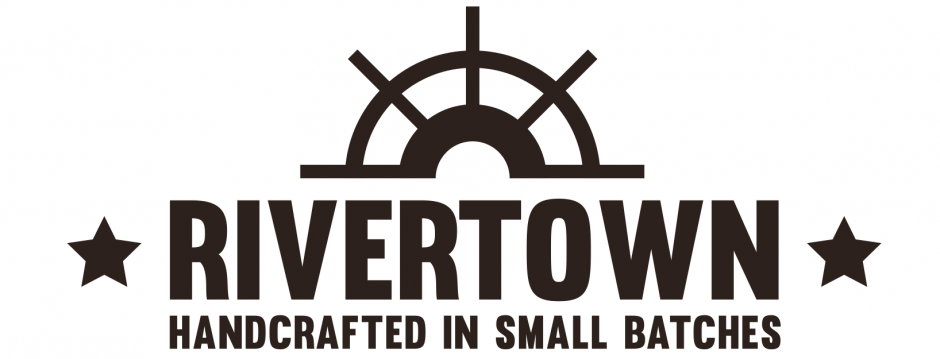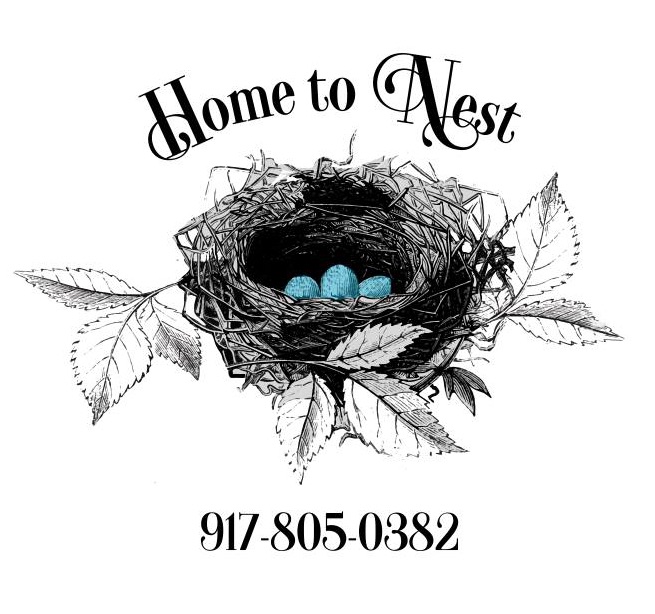Thank you to Teresa Esterle and the Alliance Integrative Medicine team for hosting the Bee Well hive in the Gaiser Bee Company apiary for the 2017 beekeeping season. We also want to thank you for being one of the first stores to support our mission of saving the bees!
Here, Cory is transferring these frames into the new box.
INSPECTION DAY MAY 14, 2017
New honeybee colonies can start from a number of sources. For the Bee Well hive, these girls started from a swarm of honeybees that we were able to rescue from a Cincinnati Public School. These honeybees were seen by the principal on the school grounds where the children frequent. He was educated on the declining population of honeybees and knew not to spray them but instead to call a beekeeper– so we headed out on April 17th to catch them.
The swarm was right outside of the school where parents pick up/drop off their children and school was almost out so we had to hurry. We were able to safely remove the bees from the tree and place them into a swarm box without anyone getting stung.
We took the bees back to our apiary and let them get acclimated with the area for a few weeks before we did anything to them. We wanted them to enjoy their home and needed the queen to start laying eggs before we did a full inspection.
Once we opened up the hive to see how they were doing, then placed them into their new custom "Bee Well" Hive, we found they LOVED the new place. The queen had laid tons of eggs, they were very calm and had a good mix of coloring. (A variety in coloring indicated to us that the colony has a good genetic diversity)
The population was exploding and they were almost ready to move out! During our inspection we noticed that the worker bees were beginning to form queen cells. Queen cells indicate to us that the hive may be preparing to swarm. This is not a bad thing– just means they have outgrown their home and are ready to move on.
So what we did was remove the many queen cups and split this hive into 2 hives. We took frames with plenty of eggs, larva and capped brood (unhatched baby bees) and placed them into a separate box. Giving this hive empty frames and plenty of room to grow. So essentially we helped them swarm but did it for them.
There is no egg in the cup, it is just in preparation for one.
Although our goal was to see the queen and mark her with a yellow color to help us find her during our inspections, we were able to see fresh eggs so we know that she was around there somewhere. So instead of keeping the hive open for longer than we needed to, we put it back together confidently, knowing that they would do great. Their population was flourishing so we expect them to continue this progress and need another box here soon.
INSPECTION DAY JUNE 9, 2017
On June 9th, we did our second inspection on the 'Bee Well' Hive, and these ladies seemed to be doing fantastic.
This colony of honeybees is flourishing and quickly growing in numbers. When we opened up the boxes, we noticed the queen seemed to favor laying her eggs in the middle of the hive, so we took the empty frames from the left and right sides of the boxes and put them between every other frame to basically fool the queen into thinking she has more space. The population is doing so well and expanding so quickly that they even started making queen cups– we noticed about three of them!
We couldn't seem to find the queen but we do know she's in there because there were an abundance of eggs and the bees were crafting their queen cups, which means they could potentially swarm. Swarming is the honeybee's natural way of reproducing and essentially creating a new colony because they have outgrown the home they're in currently. The queen cups are a signal to beekeepers to add a new box so there's enough room for the growing population.
They didn't need a new box just yet, so the next time we go down to the apiary for inspections, we will most likely be adding another box to support this thriving population.
Overall, these ladies are looking great. Stay tuned for more info on the next inspection! Be sure to follow this blog for more updates and feel free to leave comments, questions or concerns.
inspection day august 5, 2017
We went out to the apiary for another inspection on August 5th and decided to treat all of the hives for precautionary reasons. The "Bee Well" Hive was doing so well– the population was booming! We took the top off, looked at a couple frames, determined it was doing exceedingly well, then closed it back up and treated it for mites.
We're getting to that tricky time of summer when it's much too common to find the hives being infiltrated by mites and other unwanted species. We saw these bees had fallen victim so we ended up having to treat them for Parasitic Mite Syndrome(PMS).
Reports from the Ohio Department of Agriculture are indicating that the varroa mite population this season appears to be excessively high. Varroa mites are minuscule in size but they latch on like ticks and drain the life from the victim. We wanted to see if this was true with our hives so we did a thorough inspection on 10 of the hives in our apiary. Of those 10 hives, 6 had obvious signs of heavy mite infestation. Including but not limited to:
- bees with deformed wing virus
- poor honey storage
- spotty brood pattern
- larva that appears melted in their cells.
But, not to worry! Just because your hive has mites, doesn't mean it's the end of the world– or their world, really. We have started treatment and will be treating every hive in the apiary every five days for the next twenty days to ensure that the brood, currently in the larvae stage, is fully treated and protected from the varroa mite infestation once they hatch and start to grow/work. We believe these ladies will pick themselves back up and become a healthy, thriving colony once again in no time!
TREATMENTS
Because of the high number of Varroa mites throughout the entire state of Ohio, we spent the month of August treating all hives. We did an organic treatment of oxalic acid in 3 treatments, 5-7 days apart in order to treat all capped brood as they hatched.
fall extraction season: late summer - mid fall
Inspection Day September 9, 2017
After treating all of the hives and monitoring the bees behavior throughout the month, we opened their homes back up on September 9th to see how everyone was doing. We specifically went in to check on the status of the Varroa Mite treatment and to see where their food supply is at.
The treatment looks like it worked tremendously and everyone seems to be happy and healthy! Therefore, we proceeded with checking the food supply and decided to add in some Easter marshmallow candies on the inner cover until we start the feeding for fall.
Feeding during fall is necessary after extraction season so that the bees can continue building up their food supply for the winter months, before the cold gets here and they're forced to bundle up indoors just like the rest of us!
october 3, 2017 inspection day + final extraction!
On October third, we went to the apiary to gather the frames for our final extraction of the year– the beloved fall honey!
Fall honey is dark in color, plus rich and bold in flavor. It is a bit thicker and more of a dark amber color compared to spring honey. While darker honey is more flavorful and intense than light, it also contains more nutrients; including vitamins, minerals, and antioxidants.
We didn't pull many frames from the newer colonies this year so the honey you will be receiving will be coming from some of the stronger, more established hives– so yours can continue to thrive.
The final step, in the first week of November, will be to go through and consolidate some of the colonies and insulate them.
CLICK HERE to see a video of how we will be preparing the hives for winter
We will be sure to keep you updated on our next visit out to the apiary. Be sure to follow this blog for updates and feel free to post any comments, questions or concerns.
Stay tuned!









































